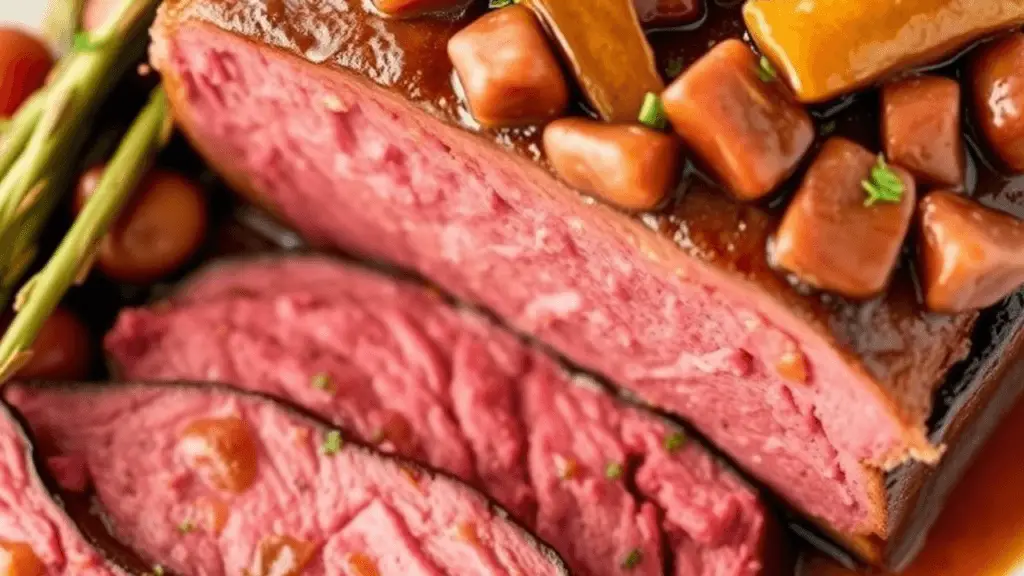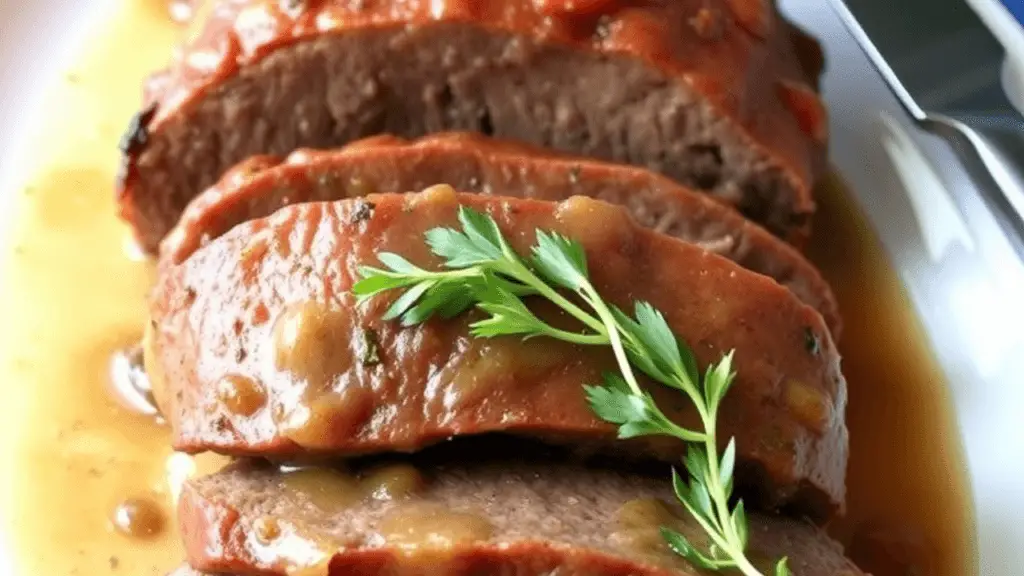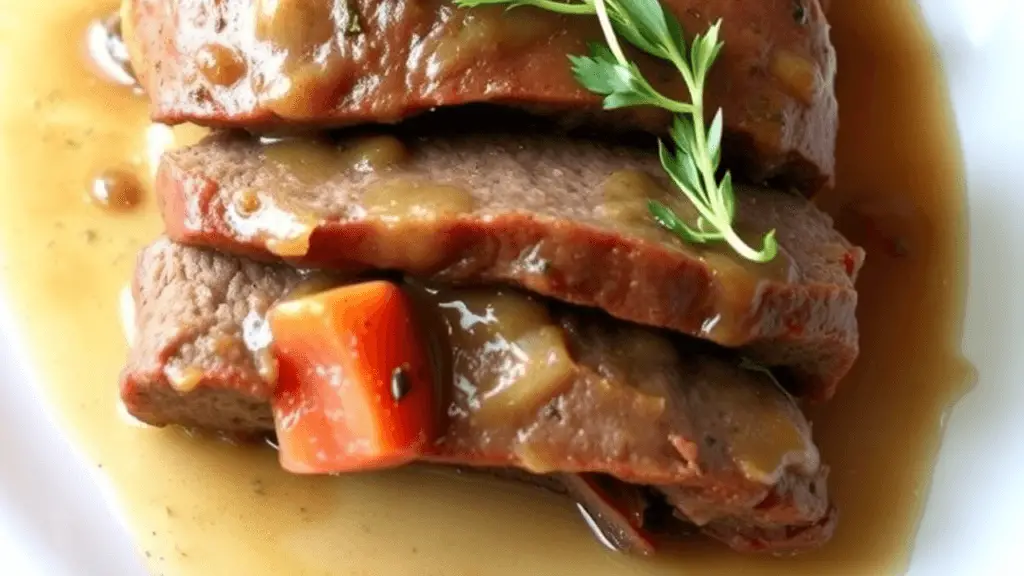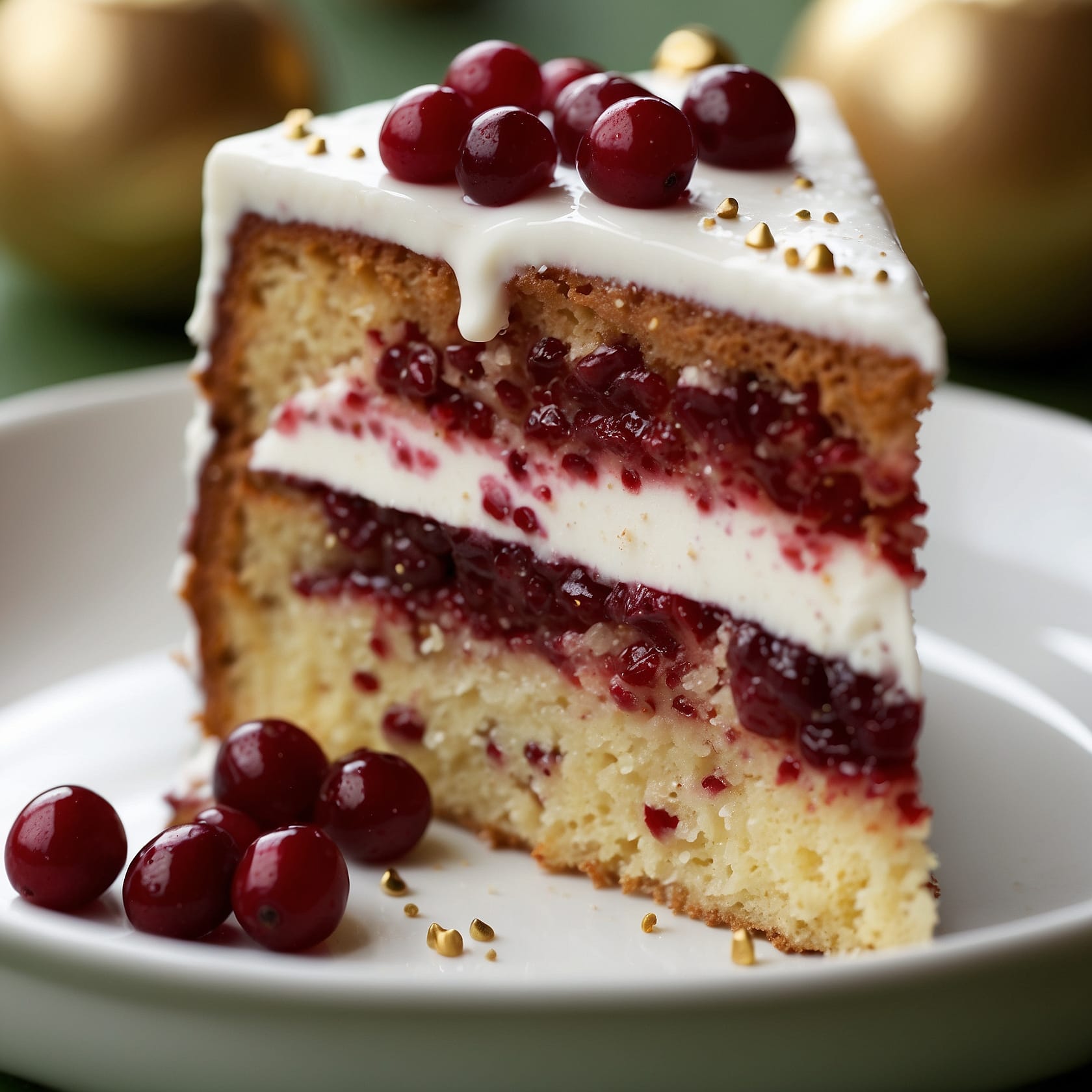Table of Contents
Introduction
The holidays are the perfect time to create a memorable meal that will delight your family and friends, and nothing says “Christmas dinner” quite like a perfectly roasted beef roast. Whether you’re looking to impress your guests with a savory and tender main dish or simply want to try something different from the usual turkey, a Best Christmas Roast Beef recipe is a fantastic choice. With a rich flavor, succulent texture, and the ability to pair beautifully with various side dishes, this recipe is sure to become a holiday favorite. Let’s dive into the details on how to prepare the best Christmas roast beef that will have everyone asking for seconds!

Choosing the Right Cut of Beef
Ingredients for the Best Christmas Roast Beef Recipe
- Beef Cut (Prime Rib, Ribeye Roast, or Sirloin Roast): 3-5 pounds (1.4-2.3 kg)
- Olive Oil: 2 tablespoons
- Garlic: 4-6 cloves, minced
- Fresh Herbs (Thyme, Rosemary): 2-3 sprigs each
- Salt and Pepper: To taste
- Butter: 3 tablespoons (for basting)
- Red Wine: ½ cup (optional, for gravy)
- Beef Broth: 2 cups (for gravy)
- Flour: 2 tablespoons (for gravy thickening)
- Vegetables for Roasting (Carrots, Potatoes, Brussels Sprouts, etc.): 3 cups (or 1-2 pounds)
- For Gravy:
- Pan Drippings: From the roast
- Wine or Broth: 1 cup
- Flour: 2 tablespoons
- Salt and Pepper: To taste
Prime Rib
Prime rib is often considered the best cut for a holiday roast due to its rich marbling and tender texture. Known for its succulent flavor, prime rib is typically served as a whole roast, allowing you to carve it into thick, juicy slices. It’s ideal for those looking to impress guests with a show-stopping centerpiece. When cooked correctly, prime rib offers a perfect balance of tenderness and flavor, with a delicious crust on the outside. It’s a classic choice for Christmas dinner and often comes with a hefty price tag, but its melt-in-your-mouth quality makes it worth the investment.

Ribeye Roast
Ribeye roast, also known as a standing rib roast without the bone, is another excellent choice for a festive Christmas roast. Ribeye cuts are well-known for their marbling, which results in a rich, flavorful, and tender roast. While it lacks the grandeur of prime rib, ribeye roast can still deliver an impressive, juicy result. It’s also often more affordable, making it a popular choice for those looking to serve a flavorful roast without breaking the bank. Ribeye roast can be cooked with the bone-in or boneless, depending on your preference.
Sirloin Roast
If you’re looking for a leaner cut without sacrificing flavor, sirloin roast is an excellent option. It’s not as fatty as prime rib or ribeye, but it’s still tender and flavorful when cooked correctly. Sirloin roast offers a more subtle, beef-forward taste, making it a great option for those who prefer a less fatty roast. It’s also typically more budget-friendly, making it a great option for larger gatherings. While it may require a little extra care in terms of seasoning and cooking to achieve maximum tenderness, it’s a versatile and delicious option for your Christmas roast.
Preparing the Beef for Roasting
Seasoning the Beef
Proper seasoning is key to bringing out the natural flavors of your roast beef. Start by generously seasoning the beef with salt and pepper, making sure to cover the entire surface. This enhances the beef’s natural taste and forms a delicious crust as it roasts. For added depth of flavor, consider using garlic powder, onion powder, dried herbs like thyme or rosemary, and even a pinch of smoked paprika. If you prefer a bolder flavor, you can rub the beef with mustard or a bit of Worcestershire sauce to add tang and richness. Seasoning your roast beef several hours before cooking, or even overnight, allows the flavors to fully penetrate the meat.
Marinating or Dry-Rub Techniques
Marinating or using a dry rub can elevate the flavor of your roast beef even further. If you choose to marinate the beef, mix olive oil, garlic, herbs, and a splash of balsamic vinegar or red wine, and allow the beef to soak in this flavorful concoction for a few hours, or ideally overnight. This will infuse the beef with additional moisture and depth. On the other hand, a dry rub, made of ground herbs, spices, and salt, will create a flavorful crust as the beef roasts, locking in the juices and adding a layer of seasoning. Dry rubs often include ingredients like black pepper, paprika, brown sugar, and cumin, and they’re perfect for those who prefer a more intense flavor without the extra moisture from marinades.

Letting the Beef Rest Before Roasting
Before placing your roast beef in the oven, let it rest at room temperature for at least 30 to 45 minutes. This helps the beef cook more evenly and prevents it from becoming tough when roasted. Allowing the meat to come to room temperature ensures that it will cook more uniformly, reducing the risk of overcooking the outside while leaving the inside too rare. Resting also helps retain the beef’s juices, ensuring a tender and flavorful roast. This step is crucial for a successful roast beef, so don’t skip it for the best results.
Cooking the Perfect Roast Beef
Oven Roasting vs. Slow Cooking
When it comes to cooking roast beef, you have two main methods: oven roasting and slow cooking. Oven roasting is the traditional technique, where the beef is cooked in a preheated oven at a high temperature for a shorter amount of time, creating a perfect crust on the outside while keeping the inside juicy and tender. This method is ideal for cuts like prime rib or ribeye roast.
Slow cooking, on the other hand, is best suited for tougher cuts of beef, such as chuck roast. It involves cooking the beef at a low temperature for a longer period of time, typically in a slow cooker or oven set at a low temperature (around 250°F/120°C). The low-and-slow method allows the collagen in the meat to break down, resulting in a super tender roast, perfect for shredding or serving with a rich sauce. While oven roasting is quicker, slow cooking provides a melt-in-your-mouth texture that is ideal for certain cuts.
Ideal Internal Temperature for Roast Beef
Achieving the perfect roast beef comes down to hitting the right internal temperature. Use a meat thermometer to check the internal temperature of the beef, ensuring it reaches the desired doneness. For a rare roast, aim for an internal temperature of 120°F (49°C), while medium-rare should be around 130°F (54°C). For medium, 140°F (60°C) is ideal, and for well-done, aim for 160°F (71°C). Remember that the roast will continue to cook slightly after you remove it from the oven due to residual heat, so it’s best to pull the beef out when it’s a few degrees below your target temperature and let it rest for 10-15 minutes before slicing.

Roasting Time and Techniques
Roasting time for beef will depend on the cut and its size. A general guideline for oven roasting is to cook the beef for about 20 minutes per pound at 350°F (175°C) for a medium-rare roast. However, larger roasts may require more time, and it’s always best to check the internal temperature using a meat thermometer to ensure perfect results.
When roasting, place the beef on a rack in a roasting pan. This allows heat to circulate around the meat, ensuring even cooking. For an added touch of flavor, consider basting the roast periodically with its own juices or a mixture of butter and herbs. If you’re cooking a fattier cut, you can start with the fat side up to allow the fat to baste the roast during cooking. This will create a rich, flavorful crust and a tender, juicy roast.
Preparing Delicious Sides to Pair with Roast Beef
Classic Mashed Potatoes
No Christmas dinner is complete without a serving of creamy mashed potatoes. The rich, velvety texture of mashed potatoes pairs perfectly with the savory flavors of roast beef, especially when smothered in gravy. For the best mashed potatoes, start with starchy potatoes like Russets or Yukon Golds. Boil them until tender, then mash them with butter, cream, and a touch of salt and pepper. For extra flavor, you can add roasted garlic, sour cream, or grated cheese. To make them extra creamy, use a hand mixer or a potato ricer for a smooth, lump-free texture. The richness of mashed potatoes balances out the hearty roast beef and creates a comforting, indulgent side dish.
Roasted Vegetables
Roasted vegetables are a delicious and colorful addition to your Christmas feast. They complement the richness of roast beef with their natural sweetness and caramelized edges. Root vegetables such as carrots, parsnips, and sweet potatoes are excellent choices for roasting. Simply toss them in olive oil, salt, and your favorite herbs, such as thyme or rosemary, and roast them in the oven alongside your beef for a one-pan meal. Brussels sprouts, cauliflower, and even squash also work wonderfully. Roasting the vegetables at high heat helps to bring out their natural sweetness, while the crispy edges add texture and flavor. The earthy tones of the roasted vegetables create a beautiful balance with the roast beef.
Yorkshire Pudding
Yorkshire pudding is a classic British side dish that’s often served with roast beef, and it’s a must-try for your Christmas dinner. Made from a simple batter of flour, eggs, milk, and a pinch of salt, Yorkshire pudding has a light, airy texture on the inside with a crispy, golden exterior. The secret to perfect Yorkshire pudding is ensuring the batter is poured into a very hot, greased muffin tin or roasting pan, which allows the pudding to puff up and become crisp. Traditionally, it’s served with gravy, and the crispy edges are perfect for soaking up those flavorful drippings from the roast beef. It’s a crowd-pleasing addition that’s both delicious and fun to make!
Making the Perfect Gravy to Accompany Roast Beef
Using Pan Drippings for Gravy
The best gravy starts with the flavorful pan drippings from your roast beef. After you’ve removed the beef from the roasting pan, leave the drippings behind to create a rich, savory base for your gravy. Place the pan on the stovetop over medium heat, scraping up any browned bits stuck to the bottom of the pan—these are full of flavor and will contribute depth to your gravy. Add a little flour to the drippings to form a roux (a thickening agent), which will help achieve a smooth, velvety texture. Using these natural drippings ensures that your gravy is infused with all the delicious flavors from the roast.
Thickening the Gravy
To achieve the perfect consistency, you need to thicken the gravy appropriately. After adding your flour to the pan drippings, cook the mixture for a couple of minutes to remove the raw taste of the flour. Gradually add liquid—either broth or wine—while whisking constantly to prevent lumps. For a rich, thicker gravy, you can simmer the mixture for several minutes until it reaches the desired consistency. If you find your gravy too thin, you can make a slurry by combining equal parts of flour and cold water, then stirring it into the gravy. Allow it to simmer for a few minutes until it thickens up. If it’s too thick, simply add more broth or water to loosen it up.
Adding Flavor with Wine or Broth
To elevate the flavor of your gravy, consider adding a splash of wine or broth. Red wine, such as a cabernet sauvignon or merlot, adds a deep, robust flavor that complements the roast beef beautifully. Pour in about ½ cup of wine, letting it cook off for a minute or two before adding your broth. Beef broth is the most common choice, but you can also use chicken or vegetable broth depending on the flavor profile you desire. The broth adds richness and body to the gravy, while the wine adds a layer of complexity and depth. For an extra boost of flavor, throw in a few sprigs of thyme or rosemary during the simmering process, and strain them out before serving. This will infuse your gravy with an aromatic, savory finish that perfectly accompanies your roast beef.
Conclusion
The Best Christmas Roast Beef recipe is the ultimate centerpiece for a festive holiday meal. By choosing the right cut, preparing the beef with love, and mastering the roasting technique, you’ll have a juicy and tender roast that will impress your guests. Pairing it with classic sides like mashed potatoes, roasted vegetables, and Yorkshire pudding, alongside a flavorful homemade gravy, will elevate your Christmas dinner to new heights. Remember, the key to perfection lies in the details—from the seasoning to the temperature, each step contributes to creating a memorable dish that will become a family favorite for years to come
For more amazing recipes, be sure to check out our other sections to explore a variety of ideas that will enrich your cooking experience. Each section offers its own unique flavors to ensure a delightful culinary journey:
- Easy and Quick Recipes: A collection of dishes that guarantee delicious meals with minimal effort and time.
- Healthy Recipes: Discover healthy and delicious options that fit your lifestyle.
- Desserts: A diverse selection of sweets that will add a special touch of sweetness to your table.
- Lunch Recipes: Tasty lunch ideas that you can easily prepare to delight your family.
- Dinner Recipes: Delicious and easy-to-make recipes that will make your dinner a memorable occasion.
FAQs
- What’s the best cut of beef for roasting?
The best cuts for a Christmas roast beef are prime rib, ribeye roast, or sirloin roast. Each cut has its unique qualities, but all offer delicious, tender meat perfect for a holiday feast. - How do I know when my roast beef is done?
Use a meat thermometer to ensure the roast reaches the desired internal temperature. For rare, it should be 120°F (49°C); for medium-rare, 130°F (54°C); for medium, 140°F (60°C); and for well-done, 160°F (71°C). - Can I use a slow cooker instead of the oven?
Yes, you can slow cook tougher cuts of beef, like chuck roast, for a tender, melt-in-your-mouth texture. Slow cooking is perfect for creating juicy, fall-apart beef without drying it out. - How do I make sure my roast beef is tender?
Let the roast rest at room temperature before cooking to ensure even roasting. Baste the beef during roasting and use a thermometer to avoid overcooking. Let the roast rest after cooking to allow the juices to redistribute.





I’ll be tryimg the roast beef recipe with prime rib.